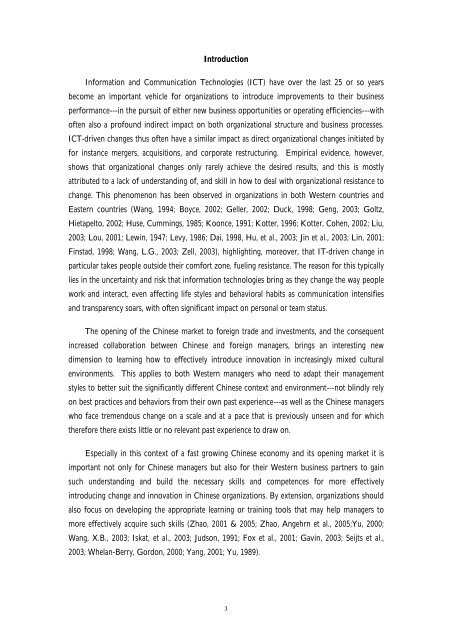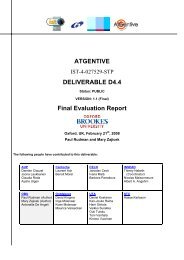LingHe Simulation - INSEAD CALT
LingHe Simulation - INSEAD CALT
LingHe Simulation - INSEAD CALT
Create successful ePaper yourself
Turn your PDF publications into a flip-book with our unique Google optimized e-Paper software.
Introduction<br />
Information and Communication Technologies (ICT) have over the last 25 or so years<br />
become an important vehicle for organizations to introduce improvements to their business<br />
performance---in the pursuit of either new business opportunities or operating efficiencies---with<br />
often also a profound indirect impact on both organizational structure and business processes.<br />
ICT-driven changes thus often have a similar impact as direct organizational changes initiated by<br />
for instance mergers, acquisitions, and corporate restructuring. Empirical evidence, however,<br />
shows that organizational changes only rarely achieve the desired results, and this is mostly<br />
attributed to a lack of understanding of, and skill in how to deal with organizational resistance to<br />
change. This phenomenon has been observed in organizations in both Western countries and<br />
Eastern countries (Wang, 1994; Boyce, 2002; Geller, 2002; Duck, 1998; Geng, 2003; Goltz,<br />
Hietapelto, 2002; Huse, Cummings, 1985; Koonce, 1991; Kotter, 1996; Kotter, Cohen, 2002; Liu,<br />
2003; Lou, 2001; Lewin, 1947; Levy, 1986; Dai, 1998, Hu, et al., 2003; Jin et al., 2003; Lin, 2001;<br />
Finstad, 1998; Wang, L.G., 2003; Zell, 2003), highlighting, moreover, that IT-driven change in<br />
particular takes people outside their comfort zone, fueling resistance. The reason for this typically<br />
lies in the uncertainty and risk that information technologies bring as they change the way people<br />
work and interact, even affecting life styles and behavioral habits as communication intensifies<br />
and transparency soars, with often significant impact on personal or team status.<br />
The opening of the Chinese market to foreign trade and investments, and the consequent<br />
increased collaboration between Chinese and foreign managers, brings an interesting new<br />
dimension to learning how to effectively introduce innovation in increasingly mixed cultural<br />
environments. This applies to both Western managers who need to adapt their management<br />
styles to better suit the significantly different Chinese context and environment---not blindly rely<br />
on best practices and behaviors from their own past experience---as well as the Chinese managers<br />
who face tremendous change on a scale and at a pace that is previously unseen and for which<br />
therefore there exists little or no relevant past experience to draw on.<br />
Especially in this context of a fast growing Chinese economy and its opening market it is<br />
important not only for Chinese managers but also for their Western business partners to gain<br />
such understanding and build the necessary skills and competences for more effectively<br />
introducing change and innovation in Chinese organizations. By extension, organizations should<br />
also focus on developing the appropriate learning or training tools that may help managers to<br />
more effectively acquire such skills (Zhao, 2001 & 2005; Zhao, Angehrn et al., 2005;Yu, 2000;<br />
Wang, X.B., 2003; Iskat, et al., 2003; Judson, 1991; Fox et al., 2001; Gavin, 2003; Seijts et al.,<br />
2003; Whelan-Berry, Gordon, 2000; Yang, 2001; Yu, 1989).<br />
3
















